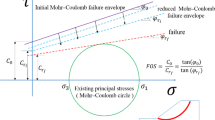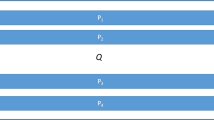Abstract
Using the Chengmenshan Copper Mine as a case study, a new methodology for open pit slope design in karst-prone ground conditions is presented based on integrated stochastic-limit equilibrium analysis. The numerical modeling and optimization design procedure contain a collection of drill core data, karst cave stochastic model generation, SLIDE simulation and bisection method optimization. Borehole investigations are performed, and the statistical result shows that the length of the karst cave fits a negative exponential distribution model, but the length of carbonatite does not exactly follow any standard distribution. The inverse transform method and acceptance–rejection method are used to reproduce the length of the karst cave and carbonatite, respectively. A code for karst cave stochastic model generation, named KCSMG, is developed. The stability of the rock slope with the karst cave stochastic model is analyzed by combining the KCSMG code and the SLIDE program. This approach is then applied to study the effect of the karst cave on the stability of the open pit slope, and a procedure to optimize the open pit slope angle is presented.




















Similar content being viewed by others

References
Agliardi F, Crosta GB, Meloni C, Rivolta C (2013) Structurally-controlled instability, damage and slope failure in a porphyry rock mass. Tectonophys 605:34–47
Akin M (2013) Slope stability problems and back analysis in heavily jointed rock mass: a case study from Manisa, Turkey. Rock Mech Rock Eng 46(2):359–371
Anderson MG, Richards KS (1987) Slope stability: geotechnical engineering and geomorphology. Wiley, New York
Beck D, Pfitzner M (2008) Interaction between deep block caves and existing, overlying caves or large open pits. Proceedings of the 5th International Conference and Exhibition on Mass Mining. Lulea University of Technology Press, Lulea, pp 381–391
Bye AR, Bell FG (2001) Stability assessment and slope design at Sandsloot open pit, South Africa. Int J Rock Mech Min Sci 38(3):449–466
Chen Z (1995) Keynote Lecture: Recent developments in slope stability analysis. Proceedings of the 8th International Congress on Rock Mechanics. Tokyo, Japan, pp 1041–1048
Cheng YM, Lansivaara T, Wei WB (2007a) Two-dimensional slope stability analysis by limit equilibrium and strength reduction methods. Comput Geotech 34(3):137–150
Cheng YM, Li L, Chi SC (2007b) Studies on six heuristic global optimization methods in the location of critical slip surface for soil slopes. Comput Geotech 34(6):462–484
Dawson EM, Roth WH, Drescher A (1999) Slope stability analysis by strength reduction. Geotechnique 49(6):835–840
Deng D, Zhao L, Li L (2014) Limit equilibrium slope stability analysis using the nonlinear strength failure criterion. Can Geotech J 52(5):563–576
Eberhardt E, Stead D, Elmo D, Dunbar S, Scoble M, Moss A (2007) Transition from surface to underground mining: integrated mapping, monitoring and modeling data to better understand complex rock mass interaction. In: Proceedings of the International Symposium on Rock Slope Stability in Open Pit Mining and Civil Engineering, Perth, Australia, Australian Centre for Geomechanics, pp. 321–332
Flores G, Karzulovic A (2004) Geotechnical guidelines for a transition from open pit to underground mining. Subsidence. ICSII. Task 4, Technical Report
Gergi M (1970) On the valuation of strength and resistance condition of the rock in natural rock mass. In: Proceedings of the 2nd Congress of the International Society for Rock Mechanics. Yugoslavian Science Press, Belgrade, pp. 365–374
Griffiths DV, Lane PA (1999) Slope stability analysis by finite element. Geotechnique 49(3):387–403
Huang RQ, Xiao HB (2010) Deformation mechanism of a shallow double-arch tunnel in a sloping rock mass. Bull Eng Geol Environ 69(1):89–97
Hustrulid WA, McCarter MK, Zyl DJAV (2001) Slope Stability in Surface Mining. Society for Mining, Metallurgy, and Exploration, Littleton
Hutchinson DJ, Phillips C, Cascante G (2002) Risk considerations for crown pillar stability assessment for mine closure planning. Geotech Geol Eng 20(1):41–63
Jing L (2003) A review of techniques, advances and outstanding issues in numerical modelling for rock mechanics and rock engineering. Int J Rock Mech Min Sci 40(3):283–353
Kwon S, Cho WJ, Han PS (2006) Concept development of an underground research tunnel for validating the Korean reference HLW disposal system. Tunnel Underground Space Technol 21(2):203–217
Lee YF, Chi YY, Juang CH, Lee DH (2012) Reliability analysis of rock wedge stability: knowledge-based clustered partitioning approach. J Geotech Geoenviron 138(6):700–708
Maiorano RMS, Russo G, Viggiani C (2014) A landslide in stiff, intact clay. Acta Geotech 9(5):817–829
Mathis JI (2009) Bench-Inter-ramp-Overall: a guide to statistically designing a rock slope. In: Slope Stability, Conference. Santiago, Chile
Moorkamp M, Heincke B, Jegen M, Roberts AW, Hobbs RW (2011) A framework for 3-D joint inversion of MT, gravity and seismic refraction data. Geophys J Int 184(1):477–493
Munoz G, Rath V (2006) Beyond smooth inversion: the use of nullspace projection for the exploration of non-uniqueness in MT. Geophys J Int 164(2):301–311
Orfanos C, Apostolopoulos G (2012) Analysis of different geophysical methods in the detection of an underground opening at a controlled test site. J Balkan Geophy Society 15(1):7–18
Rocscience (2010) SLIDE – 2D limit equilibrium slope stability for soil and rock slopes (version 6.0). Rocscience Inc., Toronto
Sarma SK (1975) Seismic stability of earth dams and embankments. Geotechnique 25(4):743–761
Sarma SK (1979) Stability Analysis of Embankments and Slopes. J Geo Eng Div ASCE 105(12):1124–1511
Sasowsky I, Bishop M (2000) Empirical study of conduit radial cross-section determination and representation methods on cavernous limestone porosity characterization. J Cave Karst Studies 68(3):130–136
Sharifzadeh M, Sharifi M, Delbari SM (2010) Back analysis of an excavated slope failure in highly fractured rock mass: the case study of Kargar slope failure (Iran). Environ Earth Sci 60(1):183–192
Sjöberg J (1999) Large scale slope stability in open pit mining–a review. PhD thesis, Lulea University of Technology
Stacey TR, Terbrugge PJ (2000) Open pit to underground–transition and interaction. Proceedings of Mass Mining Methods Advance. Brisbane, Australia, pp 97–104
Sun YK, Yang ZF, Ding BE, Yao BK, Bing Xu (1999) Open pit slope stability study in China. Chinese Science and Technology Press, Beijing (in Chinese)
Vyazmensky A, Stead D, Elmo D, Moss A (2010) Numerical analysis of block caving-induced instability in large open pit slopes: a finite element/discrete element approach. Rock Mech Rock Eng 43(1):21–39
Wan W, Cao P, Feng T, Yuan HP (2006) Analysis of slope stability for underground vacant areas based on improved genetic algorithm. Rock Soil Mech 27(11):2015–2019 (in Chinese)
Wang T, Wu HG, Li Y, Gui HZ, Zhou Y, Chen M, Xiao X, Zhou WB, Zhao XY (2013) Stability analysis of the slope around flood discharge tunnel under inner water exosmosis at Yangqu hydropower station. Comput Geotech 51:1–11
Wyllie DC, Mah CW (2004) Rock slope engineering, civil and mining, 4th edn. Spon Press, London
Elmo D, Vyazmensky A, Stead D, Rance JR (2008) Numerical analysis of pit wall deformations induced by block-caving mining: a combined FEM/DEM-DFN synthetic rock mass approach. In: Proceedings of the 5th International Conference and Exhibition on Mass Mining. Lulea University of Technology Press, Lulea, pp. 1073–1082
Yang X, Yin J (2004) Slope stability analysis with nonlinear failure criterion. J Eng Mech ASCE 130(3):267–273
Yang Z, Hou KP, Li KG, Zhang CL, Cheng Y (2010) Determination of mechanical parameters of rock mass from Yunxi Datun Tin Mine. Rock Soil Mech 31(6):1923–1928 (in Chinese)
Zienkiewicz OC, Humpheson C, Lewis RW (1975) Associated and nonassociated visco-plasticity and plasticity in soil mechanics. Geotechnique 25(4):671–689
Acknowledgments
This research is supported by the China National Natural Science Foundation (Project No. 51274249, 51174228), the Personal Training Project of Yunnan Province (Project No. KKSY201504049), the Scholarship Award for Excellent Doctoral Student Granted by Ministry of Education of China, the State Scholarship Fund from the China Scholarship Council (Project No. 201306370135) and the Doctoral Program Foundation of Higher Education of China (Project No. 20120162110009). The authors would like to express their gratitude to Mr. Shaobin Zhou, Mr. Liangjin Huang and Mr. Zhenping Yuan of Chengmenshan Copper Mine for their kind assistance throughout the project.
Author information
Authors and Affiliations
Corresponding author
Rights and permissions
About this article
Cite this article
Zhang, K., Cao, P., Ma, G. et al. A New Methodology for Open Pit Slope Design in Karst-Prone Ground Conditions Based on Integrated Stochastic-Limit Equilibrium Analysis. Rock Mech Rock Eng 49, 2737–2752 (2016). https://doi.org/10.1007/s00603-016-0924-1
Received:
Accepted:
Published:
Issue Date:
DOI: https://doi.org/10.1007/s00603-016-0924-1



